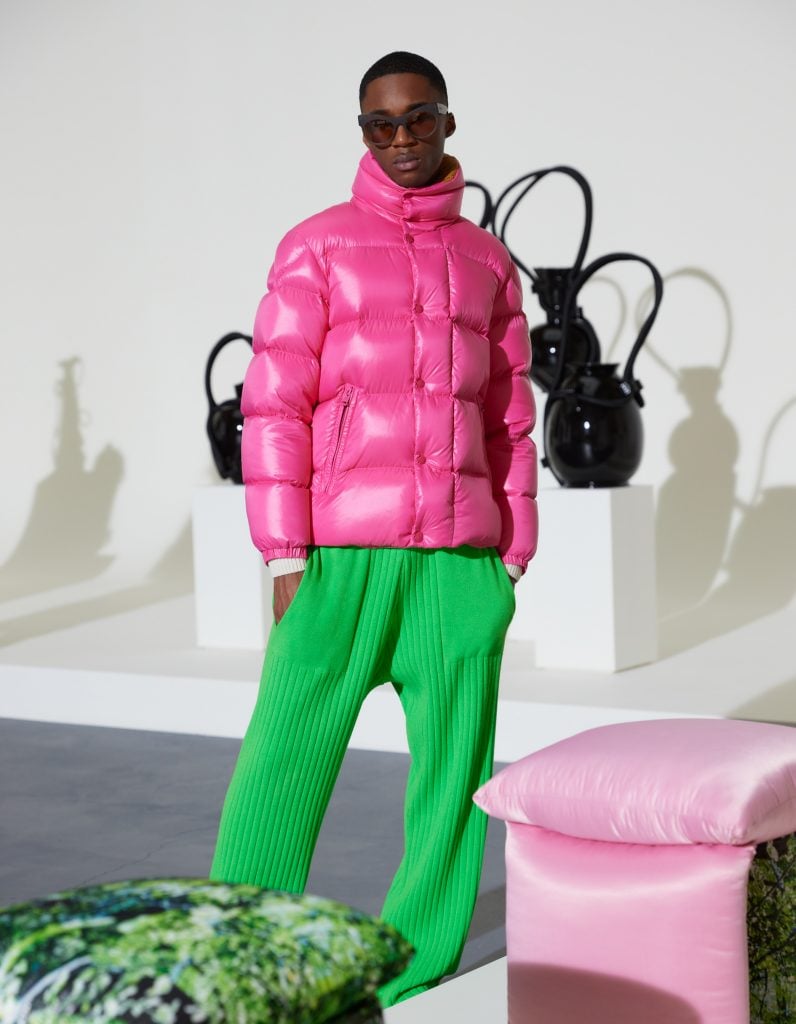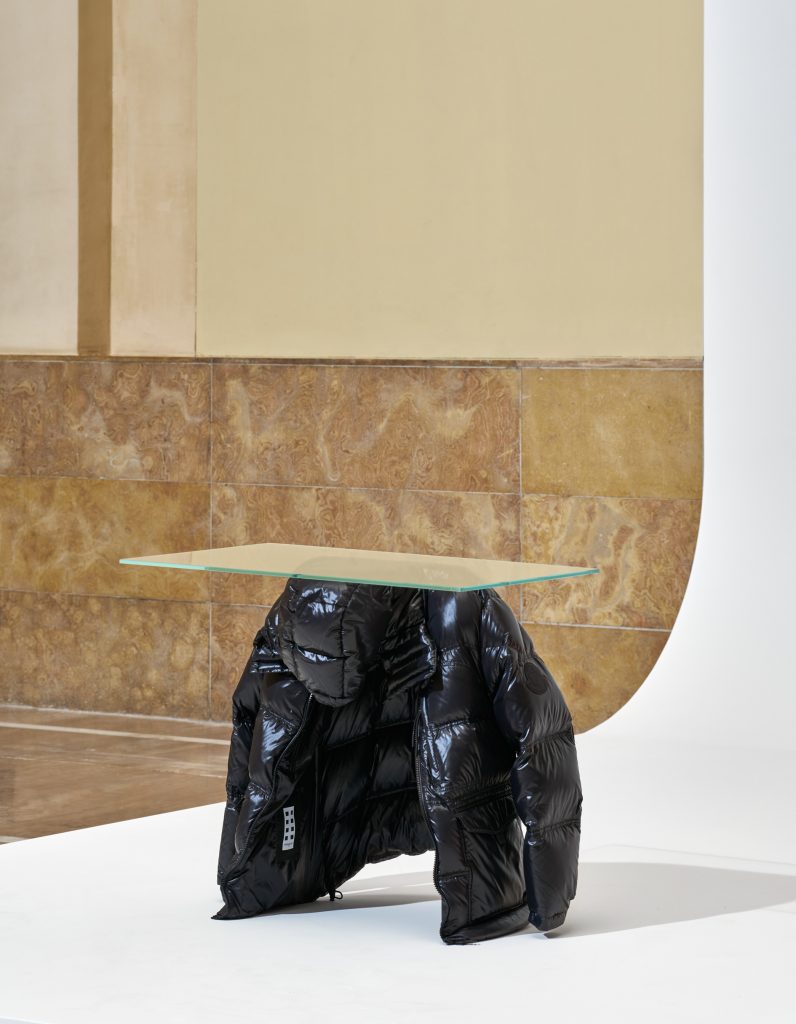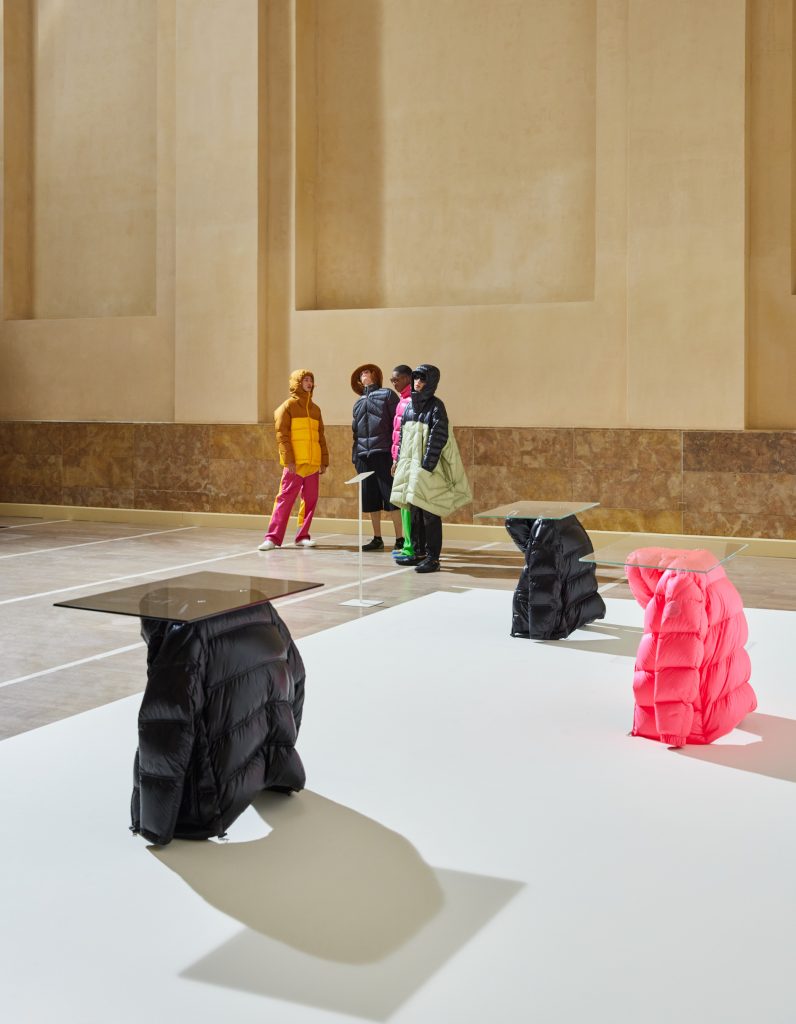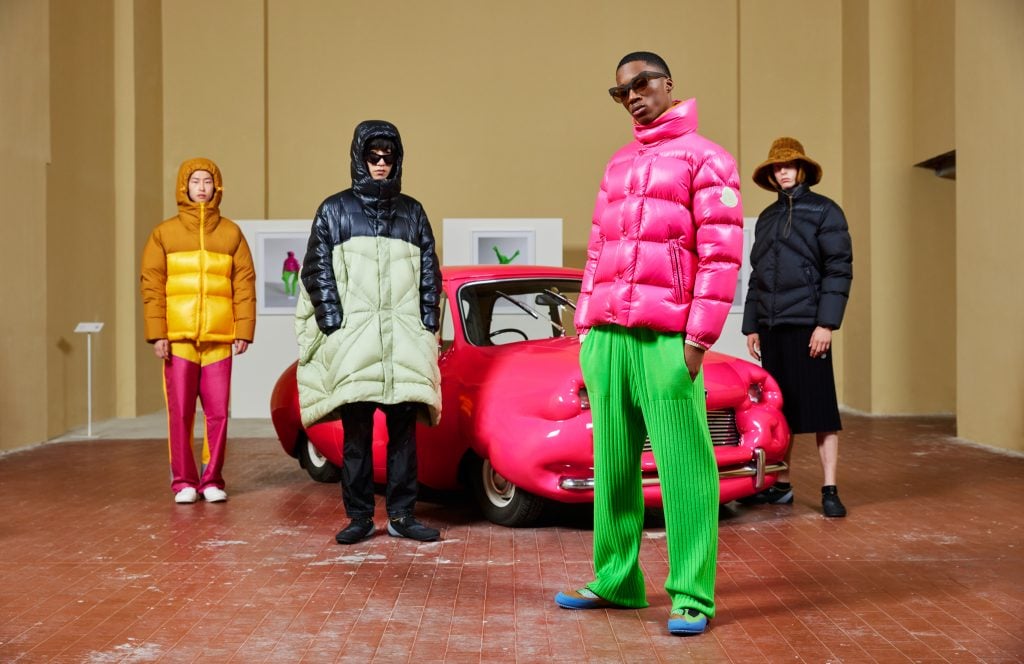People
Designer Sergio Zambon Tapped Artist Prem Sahib to Reimagine Moncler’s Iconic Puffer. They Both Learned a Lot in the Process
Creative Conversations is a series about art-making featuring visionaries from different worlds.

Creative Conversations is a series about art-making featuring visionaries from different worlds.

Christine Ajudua

On September 25, the Italian ski wear and fashion label Moncler unveiled Mondogenius, a first-of-its-kind “phygital” extravaganza featuring Moncler Genius activations from 11 designers in five cities across the globe. Among them, 2 Moncler 1952 Man creative director Sergio Zambon made his curatorial debut in Milan with “Instant Message: A One Day Exhibition,” commissioning Andrea Anastasio, Erwin Wurm, and Prem Sahib to reinterpret signature looks as works of art.
Sahib’s sculptural installations cleverly reference the architecture of public and private domains, and for Mondogenius, he turned the brand’s classic “duvet” jacket into an unlikely Puffer Desk. The London-based artist and Zambon met several years ago at an art opening in Rome and have stayed in touch ever since. They spoke with Artnet News about their cross-disciplinary collaboration, creative evolutions, and more.

Sporting a 2 Moncler 1952 Man “duvet” jacket at “Instant Message: A One Day Exhibition” on September 25 in Milan. Courtesy of Moncler.
Looking back, what led you to your current fields?
Prem Sahib (PS): I was always interested in saying something through making—I just assumed that it’d be something I’d be doing on the side. I didn’t really imagine being an artist as a career possibility up until graduating [from London’s Royal Academy of Arts]. I tried to stick around education for as long as possible, and ended up studying anthropology as well.
I grew up in the suburbs of London, in Southall, with a lot of diversity around me. My mom’s Polish and my dad was Indian, and the area has a quite large South Asian population. Race riots took place in the ‘70s and ’80s. I’m interested in how these histories communicate intergenerationally—why maybe I didn’t hear so much about them from my dad or my uncles. A lot has also to do with the sort of trauma of those histories. All those things feed into my work.
Sergio Zambon (SZ): I’m born in Egypt, on the Suez Canal. Throughout my childhood, I traveled a lot for the work of my father. He was an engineer, mainly in Africa and South America—I used to go on the big projects he was doing when I was a kid. My first love was architecture. I studied it at university one year, but I became interested more in urban planning. And I always had a feel for design and fashion.
At home, the food my mother was cooking mixed Greek, Arab, and Croatian, and she was talking on the phone to friends from all over the world. She speaks seven languages, and she was very international—even the way she was wearing things. That all influenced me, especially being a gay child and loving fashion. After one year of architecture, I started school for fashion in Italy.
When and how did you meet?
PS: We met at an art opening, didn’t we?
SZ: At the Lorcan O’Neill gallery in Rome, about seven or eight years ago. That’s when I started following Prem’s work; I really liked it from the start. What seduced me was the [balance] between art and design, the minimalism, the different topics I can read visually. I feel a love for design, and his objects are talking to me not only about art, but also—if I’m not wrong—about things like clubbing.
PS: Yeah—I used to be involved, slash I am involved, in a London club night called Anal House Meltdown. We did a special mix for the event.
How did this collaboration come about?
SZ: I wanted to do an event related to my love for art and design—without clothing, but related to clothing and to the company—and it organically became an exhibition with two artists and a designer of furniture who I know. There was an artwork of Prem’s with puffer jackets squeezed in glass, which naturally linked with Moncler.
PS: I’ve known Sergio’s work since his time at Fendi and Acne, and I was always really drawn to his attentiveness to contemporary art. When he proposed a collaboration, the initial conversation centered around some of my works that incorporated clothing already, but it was very open.
I told him about things that interested me—like Scott Burton’s Two-Part Chair. I like how that was made with these two constituent parts that support one another. That became a foundation for me to think about something on the border between a functional object and an artwork.

Prem Sahib’s Puffer Desk. Courtesy of Moncler.
We’d love to hear about your thinking behind Puffer Desk. You created it with a glass sheet positioned atop a solitary, disembodied puffer jacket—notably, with its head down.
PS: In a really simple sense, the fact that a lot of us were working from home and directing our attention to this one small space—I don’t need to say that we all felt isolated from one another.
The specificity of producing a desk was sort of bound up with ideas around labor and personal space within domestic and public settings—so thinking about the desk as a site where bodies are directed to tasks that take them away from their here and now; things like writing and scrolling and viewing. The scale of it is based on this small fold-up desk that I happened to be using during lockdown.
And then there’s obviously something quite emotional about how the object might be read as well—you see this kind of weight on its shoulders. This kind of melancholic character emerged, carrying a burden on its back.
SZ: I have to say, when I saw it live, it was very powerful. It reminded me of Allen Jones’s Table—in a contemporary way, of course.
PS: It wasn’t a specific reference, but of course I see the relationship. There’s something about performing, I think, which is implicit in the object—like a body performing—and that brings me to thinking about relationships around power and subversion as well.
Sitting at it was definitely strange. It’s nice and warm; it keeps your legs quite toasty.
You come from different disciplines, different generations, different worlds. What unique perspectives did you offer each other, and what did you learn from each other’s processes?
PS: In my past work, my use of jackets, for example, tended to stem more from thinking about their ubiquity as social signifiers. Working on this project with Sergio—having to dismantle parts of the puffer, to find ways for it to behave differently than [originally] intended—made me appreciate the engineering and design element more. You know, how do you make something floppy and light like fabric support something heavy and rigid like glass?
Normally my sculptures are these precarious balancing acts that sort of teeter on the edge of collapse. And so one of the things I really enjoyed about this project was actually trying to work on something that didn’t adhere to that illusion in a way, and demystified some of the process.
SZ: It was new for me to collaborate in kind of an invisible way, where [artists use] my designs to express something else. That was a learning process, because generally, I’m the enactor of the process from A to Zed. But yeah, I completely trust these artists.
What have been the biggest challenges of this project?
SZ: Well, it’s my first curatorial experience, without sounding too pretentious. The funny thing is, I didn’t experience it as a challenge. Working with other creatives is a challenge of relation, of how to understand the rhythm of their work—but it happened in a very spontaneous way.
PS: To me, the main challenge was a technical one, really—like, trying to get almost 30 kilos of metal inside a very delicate jacket, and taking my sculptural language to a place where it has to perform beyond just the pictorial or the imagined. How do you make this illusion, something that’s a fragile object, but that someone can sit at and write?

Variations of Puffer Desk. Courtesy of Moncler.
How has the last year and a half impacted you creatively?
SZ: For me and, I think, for lots of people in my field, it made mandatory what before were more radical cultural ideas—for example, we realized we have to do more as a community; we have to be more sustainable. That’s a positive.
But I have to say, travel is very important, not only to my projects, but to my persona—probably because I grew up traveling a lot. From the moment I depart, seeing people in the airport, it’s like I recreate myself. So not traveling for me was a really bad thing.
PS: I have struggled a lot creatively this past year, not just with the pandemic—I think how I tap into creativity is through going out—but also everything that’s been going on politically. It hasn’t necessarily been a massively prolific time in terms of my making, but it has been more introspective and experimental.
[This project] happened at a good time for me, you know. I’m in my head a lot, and I think it helped dislodge something. That slightly different framing of [the work] as a design object afforded me a different type of freedom somehow.
In which ways do you feel that the art and design worlds are different—and also similar?
SZ: I think it’s the level of meaning and importance of expression related to time. Art has more of an eternal goal. Fashion, it’s specific to a certain time. And in design, you have [both].
PS: There’s a mutual language with which artists and designers can communicate and create. I don’t think all design is just about problem solving; I think it can also be about imagining new futures, which is something that I associate a lot with art as well.
What makes good art?
PS: I don’t know if I find a good-bad binary useful—because some supposedly bad art can be quite good at reflecting the times—but what tends to interest me is detecting some kind of sincerity, but also weirdness or risk-taking in what is trying to be communicated. I think it’s something that I have an emotional connection to.
SZ: It is emotional. I feel something immediately—I’m attracted; I have to stop in front [of the work]. That’s the sign there is something there.
PS: It’s not always explainable through language, I find.
SZ: No. Sometimes I discover an artist or a designer and I immediately feel something. It’s the quality of pureness, if I have to say it in like three words.

Another unexpected take on the Moncler puffer: Erwin Wurm’s Fat Mini. Courtesy of Moncler.
If you could switch lives for a day, what would each of you be excited about doing?
PS: I would imagine that Sergio’s life is full of more glamour, and being surrounded by fashion might mean that I could acquire a half decent wardrobe.
But on a serious note, it would be interesting to see what it was like to build a collection that goes out into the world and is actually worn, and doesn’t have [to be in] the confines of a museum or a gallery or something to go and see it.
SZ: We [designers] always have to face the trade topic, though. Maybe I just fantasize, but I would like to have the same creative freedom Prem has. And then, of course, the glamour of opening in a big gallery.